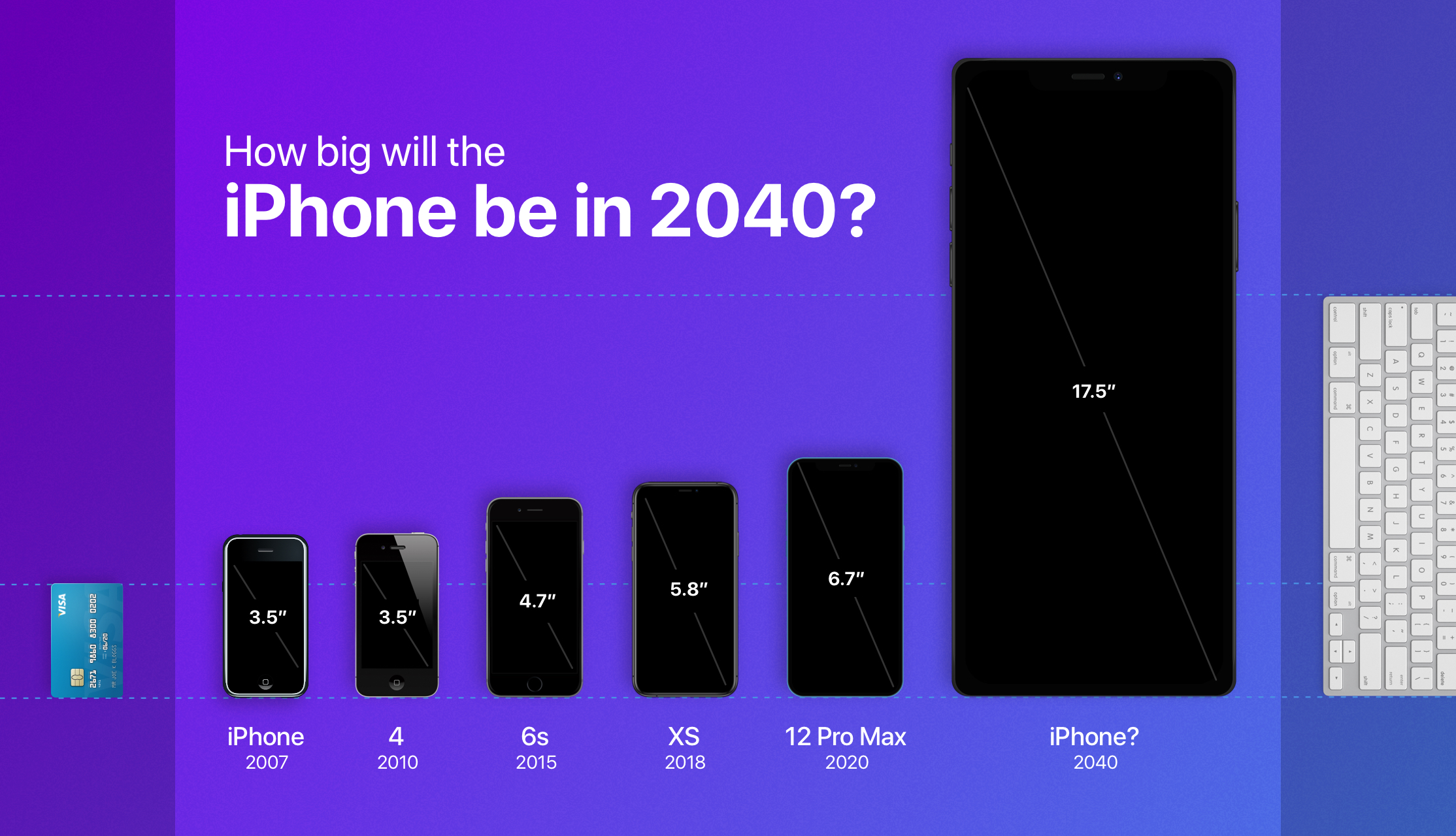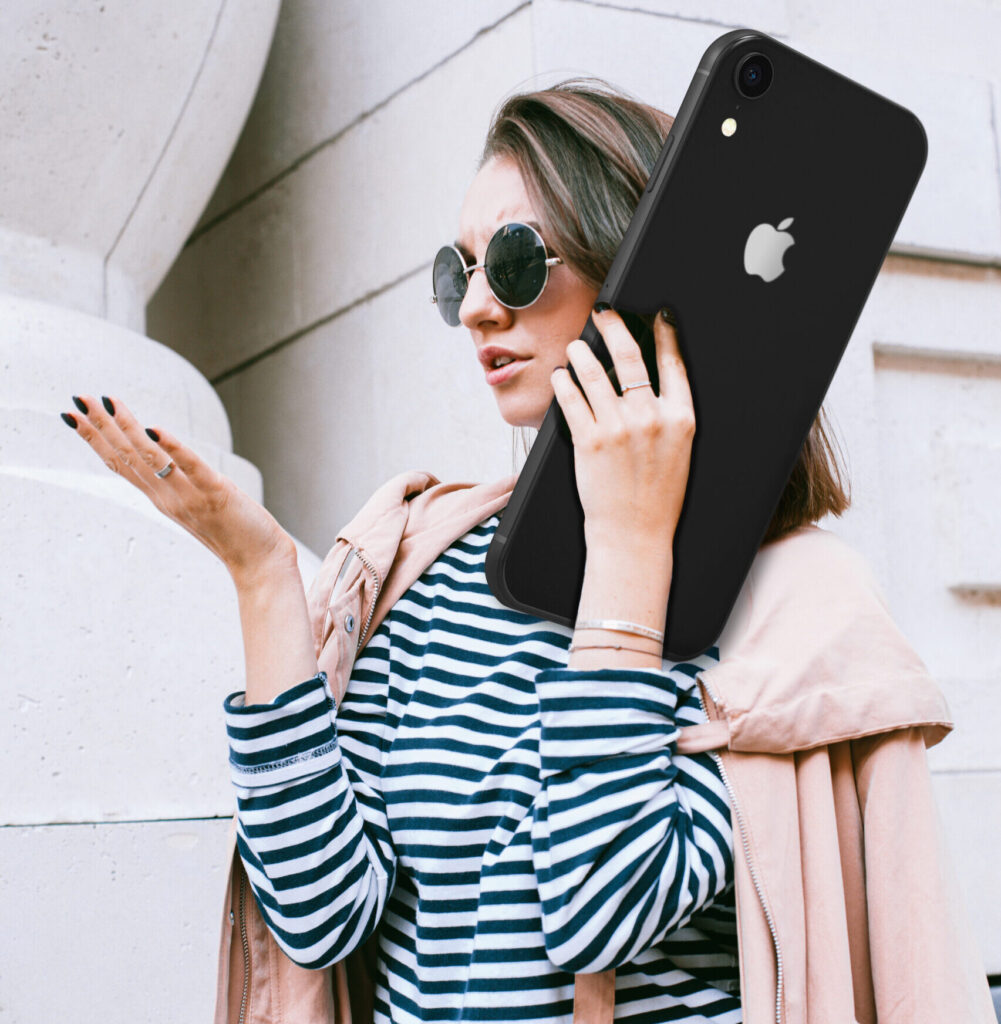Following the unveiling of the highly anticipated iPhone 12, we’ve taken a deep dive into the evolution of the smartphone. Having analysed the technological advances made to phones over the last two decades, we’ve also predicted how Apple will develop its most popular product in the next 20 years. From holographic displays to the rise of foldable frames – here’s what we’ve discovered.
Evolution of the iPhone: Size matters
From the camera quality to advancements of technology networks, we’ve seen the iPhone incorporate a number of changes since its launch in 2007. However, perhaps the most noticeable change we’ve seen has been its size increase. While the first iPhone in 2007 had a screen size of just 3.5-inches, the recently announced iPhone 12 Pro Max is almost double the size at 6.7-inches. In total, that equates to a 91 per cent increase and an average growth of 5 per cent year-on-year. The graphic below shows how the iPhone has grown over the last 13 years. Despite it starting out only slightly bigger than a credit card, if it continues to grow at its current rate the iPhone will be bigger than an Apple Mac keyboard by 2040. With a display size of 17.5-inches it will also be taller than a bottle of wine.

While the predicted size of the iPhone may seem extreme, there are a number of features Apple could introduce in order to make it practical for users while taking advantage of the opportunities such a big screen would create.
The iPhone isn’t the only smartphone which has grown at a considerable rate in recent years either. Despite launching two years later, the Samsung Galaxy has increased in size at a quicker rate. With the original model having started with a display size of 3.2-inches, the Galaxy Note 20 Ultra released in August this year is 6.9-inches – a 7 per cent increase year-on-year. The Google Pixel has also grown at the same rate since launching in 2016. While the Huawei P series has seen a more modest growth in the last eight years, the trend of smartphones increasing in size is clear to see.
| Model | Screen size of first mode | Screen size of latest model | Year-on-year increase |
|---|---|---|---|
| Samsung Galaxy | 3.2-inches | 6.9-inches | 7% |
| Google Pixel | 5-inches | 6.3-inches | 7% |
| iPhone | 3.5-inches | 6.7-inches | 5% |
| Huawei P Series | 4.3-inches | 6.6-inches | 4% |
Commenting on the study, director of Wrappz, Liam Williams, said: “With an estimated 52.5 million sales in the UK since 2011, the iPhone really has led the way in the smartphone market. The tech giants are constantly innovating and evolving their devices so it has been fascinating to compare the development of the iPhone to its competitors.
“While a large display size offers a great user experience, it is clear to see a compromise will need to be had in the coming years in order to ensure smartphones remain practical. As research continues into the development of cutting-edge technology, Apple will be keen to stay one step ahead of its competitors by implementing the latest technical advancements in the next two decades.”
Are phones growing too quickly?
While the size of smartphones has been increasing over the last decade, the average hand size has remained the same. Should the iPhone continue to grow at its current rate, it will be too big for women by next year. A study of the human body by NASA found the average length of a female’s hand is 6.8-inches and with the iPhone predicted to be 6.9-inches by 2021, it would be 0.1-inch too big for the average woman. By 2024 the iPhone will have outgrown men who have an average hand length of 7.6-inches according to NASA’s study.

In a recent survey by Android Authority, a staggering 75 per cent of people believed phones were becoming too big. Not only is the growth of smartphones seemingly undesirable from a user’s perspective, it is also starting to have an impact on our physical health as well. Impediments including ‘smartphone pinky’, ‘tech neck’ and ‘text claw’ are becoming more common among youngsters in particular – a concerning trend to say the least.
Potential features for the iPhone in 2040
In the past 20 years the capabilities of mobile phones have improved greatly. These days we rely on them in almost every aspect of our life whether that be as an alarm to wake us up in the morning or as a portable map to take us to our desired destinations. With the tech giants continually looking to evolve and innovate their devices, we’ve compiled a list of features we believe the iPhone in 2040 could have based off the research currently taking place.

Foldable frame
While foldable phones aren’t mainstream devices just yet, they are starting to grow in popularity with technology companies continuing to improve them. Two of Apple’s biggest competitors Samsung and Huawei have already successfully released foldable phones this year in the form of the Samsung Galaxy Z Flip and the Huawei Mate Xs. Although Apple hasn’t announced any plans to release a foldable phone, there have been plenty of suggestions that it is working on one. Over the last few years, Apple has been granted a number of patents for foldable devices adding further fuel to this speculation. Developing a foldable phone would enable the iPhone to continue growing in size while remaining practical for people to carry around in a pocket or bag.
Holographic display
It’s fair to say despite the Red Hydrogen One being billed as a revolutionary creation due to its ‘holographic’ display, it did very little to instill optimism that 3D phone displays are going to be adopted by the big players any time soon. Since its release in 2018 however, it has been revealed Samsung is working on inventing a docking station which will be able to display information such as notifications in the air. Apple has also been working on a set of augmented reality wearable peripherals for some time which would allow a computer-generated image to be projected into the real world, heightening excitement for such technology.
While holographic displays would undoubtedly take mobile gaming to the next level, it is the impact it could have on e-learning which may be more of a draw for many. Schools, universities and businesses have been forced to adopt a more remote way of operating in recent months and with many happy to continue in this way for the foreseeable future, holographic displays could go a long way to optimising this way of working. Although developing such a complex system will take time, there’s every chance the coronavirus crisis has helped to strengthen the argument for smartphones integrating 3D technology.
Mind control
From driverless cars to artificial intelligence, there have been a number of fascinating technological advancements made over the last decade. While being able to type a message or search for a playlist using just your mind would be the biggest of them all, there’s every chance by 2040 you’ll be able to do just that by controlling a smartphone with your brain. In recent years, Facebook has teamed up with researchers at the University of California, San Francisco, to study whether it’s possible to decode speech from a person’s brain activity on a computer screen. While the research remains in the early stages, it represents the first steps towards such technology being introduced. 20 years is a long time in the tech world, so you wouldn’t bet against mind control being rolled out across a number of our most popular devices by 2040.
Tech expert and co-founder of mobile entertainment company Live Tech Games, Nathan Moore, believes the continued evolution of smartphones will be particularly welcome in the gaming industry.
He said: “Working in the gaming industry, we know how much of an impact it can make on user experience if the graphics and audiovisual content are of the highest quality. A holographic display feature would create a gaming experience as close to real life as possible, without stepping into the world of virtual reality.
“These predicted features are not only viable but the growth they offer for user experience would drive the direction of the industry. In a fast-paced digital world, mobile users are constantly looking for new ways to spark their interest and the attention economy is one of the most sought after.”
Methodology
We compared the size of the first iPhone in 2007 to the size of the iPhone 12 Pro Max to work out how quickly the phone has grown in the last 13 years. Growing at 5 percent year-on-year, we predict the iPhone in 2040 to have a display size of 17.5-inches. A phone with a height of 440mm and a width of 185mm would allow for a 17.5-inch screen.
NASA calculated the average hand length by measuring the distance from the tip of the longest finger to the crease under the palm.
Design and personalise your iPhone 12 phone case
If you’re counting down the days until you can get your hands on the all-new iPhone 12, then why not design your very own iPhone case here at Wrappz. You can create personalised phone cases with our huge range of phone cases, easy to use templates and in-browser designer app.

